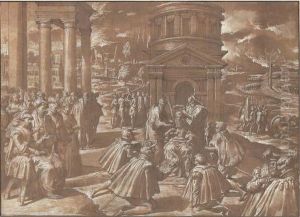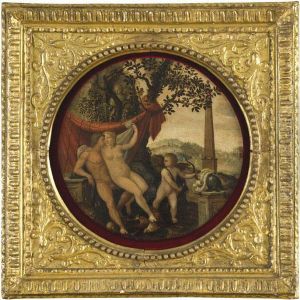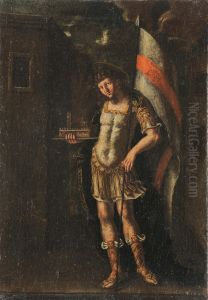Niccolo Dell'Abate Paintings
Niccolò dell'Abbate, sometimes spelled Niccolò dell'Abbati or Nicolo dell'Abbate, was an Italian Mannerist painter and decorator born in Modena, Italy, in the early 16th century. His exact birth year is uncertain, with sources suggesting either 1509 or 1512. Dell'Abbate's work, which primarily spanned the genres of landscape and mythological narrative, played a significant role in the transition of Italian art from the High Renaissance to the Mannerist style. He was part of the School of Fontainebleau, which significantly influenced the introduction of Italian artistic styles into France.
Dell'Abbate began his career in Modena, under the tutelage of Antonio Begarelli, a local modeller in clay. His early works were frescoes in the houses of the Modenese nobility, where he depicted various subjects from Roman mythology. By the mid-16th century, his reputation as a skilled painter had grown, leading to commissions beyond his hometown, including work in Bologna, where he painted for the Palazzo Fantuzzi and the church of San Giacomo Maggiore, showcasing his talent in both religious and secular subjects.
In 1552, Dell'Abbate moved to France, invited by Primaticcio to join the first school of Fontainebleau, which was a center for artistic innovation under the patronage of King Francis I. His work there, alongside other Italian artists, was instrumental in spreading Renaissance and Mannerist styles in France. He adapted his Italianate style to French tastes, executing large-scale frescoes, decorative stucco work, and landscape scenes that were notable for their elegant figures and detailed naturalism. Among his most famous works in France are the decorations for the Château de Fontainebleau, including the Gallery of Ulysses, now lost, and various hunting scenes, pastoral landscapes, and mythological subjects that influenced the development of landscape painting in France.
Dell'Abbate's influence extended beyond his immediate works. His landscapes, characterized by their serene beauty and meticulous detail, had a profound impact on the development of French art, heralding the beginnings of the classical landscape tradition that would come to dominate European painting. Despite his significant contributions, Dell'Abbate's work was somewhat overshadowed by his contemporaries, and only in recent years has his importance been fully acknowledged by art historians.
Niccolò dell'Abbate died in Paris in 1571, leaving behind a legacy that bridged Italian Renaissance art with French Mannerism. His work remains a testament to the cultural exchange between Italy and France in the 16th century and the enduring appeal of the Mannerist style.



